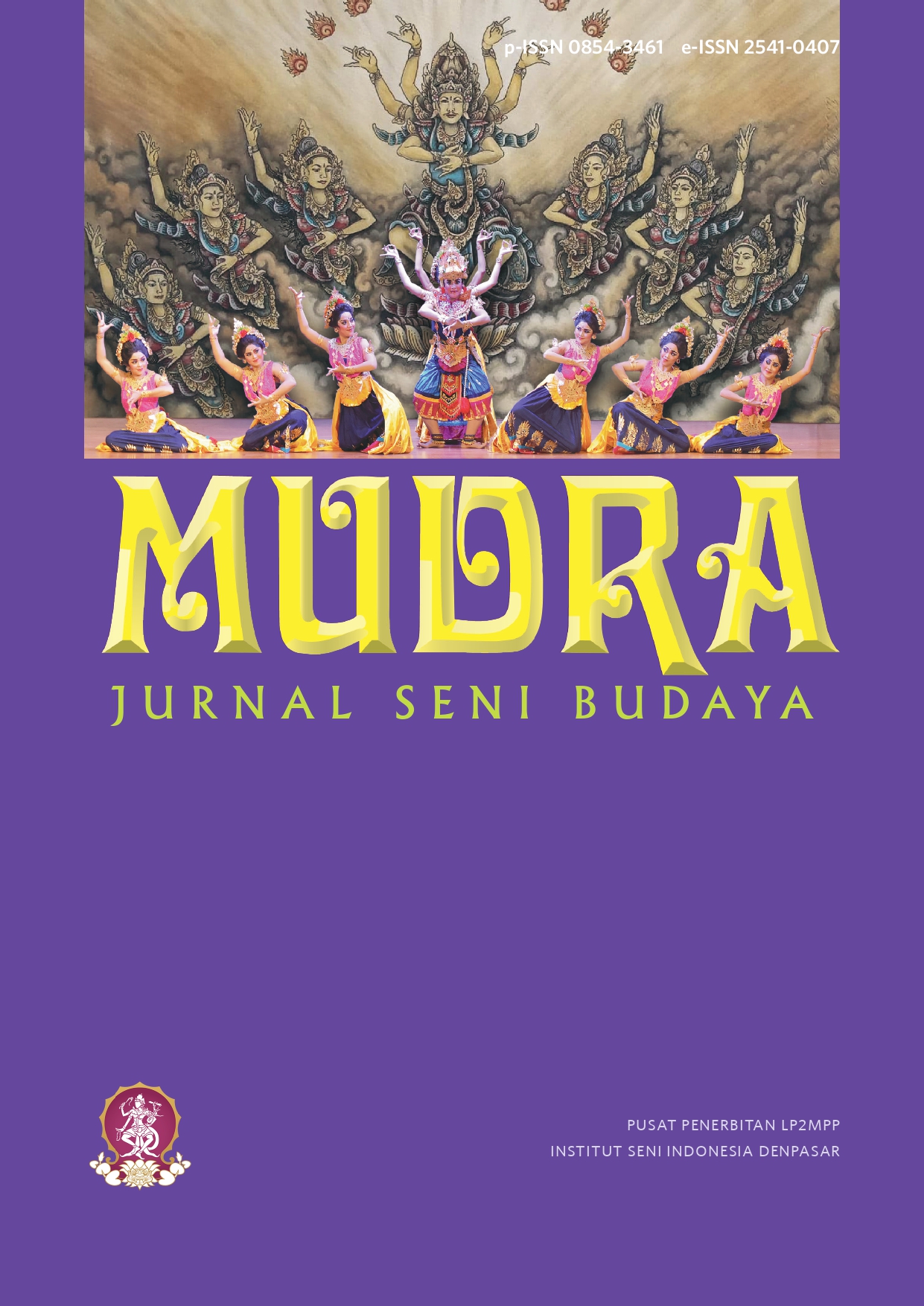Aesthetics of Jaran Ukir Decorating Tempel Technique of Kasongan Village Pottery
DOI:
https://doi.org/10.31091/mudra.v40i1.2946Keywords:
Aesthetics, Kasongan, Jaran Ukir, Tempel Technique, New Creation, GlobalAbstract
This research aims to create a new creation carved with the characteristic of tempel technique decoration, which is the strength of the local genius of Kasongan Village pottery that meets the quality standards of raw materials and modern design. Other regions do not own the tempel technique decoration that characterizes Kasongan Village pottery. However, its existence is starting to recede, with poor regeneration, and is no longer to the needs of the times. Direct hand-building pottery products with tempel technique decorations are complicated, difficult, and old-fashioned. The younger generation prefers to make printed pottery products that are considered more practical to be created with fabricated paint finishing according to global tastes while ignoring the local identity of Kasongan Village pottery characteristics. This research uses aesthetic methods with a practice-based research approach carried out with the stages of literature research, empiric study, visual research, and practice. The aesthetics of the new Kasongan carving, with the application of the tempel decoration technique, impact the preservation of sustainable local artistic creations. Creating a new carving with the tempel technique decoration in Kasongan Village is expected to be an educational tool for learning about the character of the nation's next generation from an environmental and cultural perspective. Carving with tempel technique decoration is an entity that must be maintained, preserved, and developed according to the global community's needs.
Downloads
References
T. Raharjo, “Gerabah Kasongan ‘Jaran Ukir’ Ikon Kabupaten Bantul dalam Perspektif Ilmu Kriya,” presented at the Pidato Pengukuhan Jabatan Guru Besar dalam Bidang Kriya pada Fakultas Seni Rupa Institut Seni Indonesia Yogyakarta, Yogyakarta, Mar. 29, 2023.
N. D. Astuti, “Pengelolaan dan Pemanfaatan Limbah Keramik Bayat sebagai Alternatif Material Produk Kerajinan Tangan,” Ekspresi Seni: Jurnal Ilmu Pengetahuan dan Karya Seni, vol. 20, no. 2, pp. 88–101, 2018.
D. S. Kartika, Estetika. Rekayasa Sains, 2007.
J. Malins, J. Ure, and C. Gray, “The Gap: Addressing Practice-Based Research Training Requirements for Designers,” The Robert University, Aberdeen, United Kingdom, 1996.
A. A. M. Djelantik, T. Rahzen, and N. N. M. Suryani, Estetika: Sebuah Pengantar. Masyarakat Seni Pertunjukan Indonesia, 1999.
D. K. Seftianingsih, “Pengenalan Berbagai Jenis Furniture dengan Kombinasi Material Beserta Kontruksinya,” JURNAL KEMADHA, vol. 7, no. 1, Art. no. 1, Oct. 2017, Accessed: Feb. 11, 2025. [Online]. Available: https://jurnal.usahidsolo.ac.id/index.php/kmd/article/view/473
B. Sudardi and I. Istadiyantha, “The Prince of Diponegoro: The Knight of the Javanese War, his profile of the spirit and struggle against the invaders,” International Journal of Multicultural and Multireligious Understanding, vol. 6, no. 5, pp. 486–493, 2019.
H. S. Mohd. Yakin, A. Totu, and R. Derak, “Simbol Binatang Ternakan dan Konsep Artifak sebagai Manifestasi Identiti Budaya dan Identifikasi Etnik Peribumi Sabah: Satu Kajian dari Perspektif Komunikasi,” MANU, Dec. 2016, doi: 10.51200/manu.v24i0.523.
T. Triyanto, M. Mujiyono, and E. Sugiarto, “Aesthetic Adaptation as a Culture Strategy in Preserving the Local Creative Potentials,” komunitas, vol. 9, no. 2, pp. 255–266, Sep. 2017, doi: 10.15294/komunitas.v9i2.9522.
S. Gustami, “Seni Kerajinan Keramik Kasongan Yogyakarta Kontinuitas dan Perubahannya,” Universitas Gadjah Mada, 1988. Accessed: Feb. 10, 2025. [Online]. Available: https://etd.repository.ugm.ac.id/penelitian/detail/13870
R. M. Soedarsono, Seni Pertunjukan dan Pariwisata: Rangkuman Esai tentang Seni Pertunjukan Indonesia dan Pariwisata. Badan Penerbit ISI, 1999. Accessed: Jan. 17, 2025. [Online]. Available: //lib.pasca.isi.ac.id%2Findex.php%3Fp%3Dshow_detail%26id%3D1510
I. W. Mudana and P. K. Ribek, “Komodifikasi Seni Lukis Wayang Kamasan Sebagai Produk Industri Kreatif Penunjang Pariwisata,” Mudra Jurnal Seni Budaya, vol. 32, no. 1, Art. no. 1, Jun. 2017, doi: 10.31091/mudra.v32i1.83.
P. N. P. Laras, “Aesthetic Characters of Flora and Fauna Painting Art Pengosekan on Visual Objects Wood Carving Craft Arts in Singakerta Village, Ubud,” Mudra Jurnal Seni Budaya, vol. 39, no. 2, Art. no. 2, Apr. 2024, doi: 10.31091/mudra.v39i2.2777.
A. S. Bahri, A. Basalamah, F. A. A, and T. A. Rahmat, “Penerapan Kriteria Desa Wisata pada Desa Wisata Batulayang, Bogor, Jawa Barat,” KONTAN: Jurnal Ekonomi, Manajemen dan Bisnis, vol. 2, no. 1, Apr. 2023, doi: 10.59818/kontan.v2i1.428.
T. Raharjo, Historisitas Desa Gerabah Kasongan, Cet. 1. Yogyakarta: Program Pascasarjana, ISI Yogyakarta, 2009.
I. B. Sugiharto, Untuk Apa Seni? Bandung: Matahari, 2013.
I. G. A. A. I. Mas and I. G. A. Kurniawan, “Pentingnya Kesadaran Menjaga Kesenian Khususnya Kesenian Daerah Bali pada Anak Sekolah Dasar Desa Mengesta,” Imajinasi: Jurnal Seni, vol. 17, no. 2, pp. 57–62, 2023.
Z. M. Bizawie, "DIPONEGORO AND THE ULAMA NUSANTARA NETWORK," The International Journal of Pegon : Islam Nusantara civilization, vol. 3, no. 01, Art. no. 01, Apr. 2020, doi: 10.51925/inc.v3i02.26.
J. Fischer and J. Danandjaja, The Folk Art of Java. in The Asia collection. Kuala Lumpur ; ew York: Oxford University Press, 1994.
W. D. Kingery, H. K. Bowen, and D. R. Uhlmann, Introduction to Ceramics. John Wiley & Sons, 1976.
S. Gustami, Seni Kerajinan Mebel Ukir Jepara: Kajian Estetika melalui Pendekatan Multidisiplin. Penerbit Kanisius, 2000.
Downloads
Published
How to Cite
Issue
Section
License
Copyright (c) 2025 Dyah Retno Fitriani, Arif Suharson, Awang Ridho

This work is licensed under a Creative Commons Attribution-NonCommercial-ShareAlike 4.0 International License.
- Copyright on any open access article in a journal published by Mudra Jurnal Seni Budaya is retained by the author(s).
-
The Creative Commons Attribution License 4.0 formalizes these and other terms and conditions of publishing articles.









